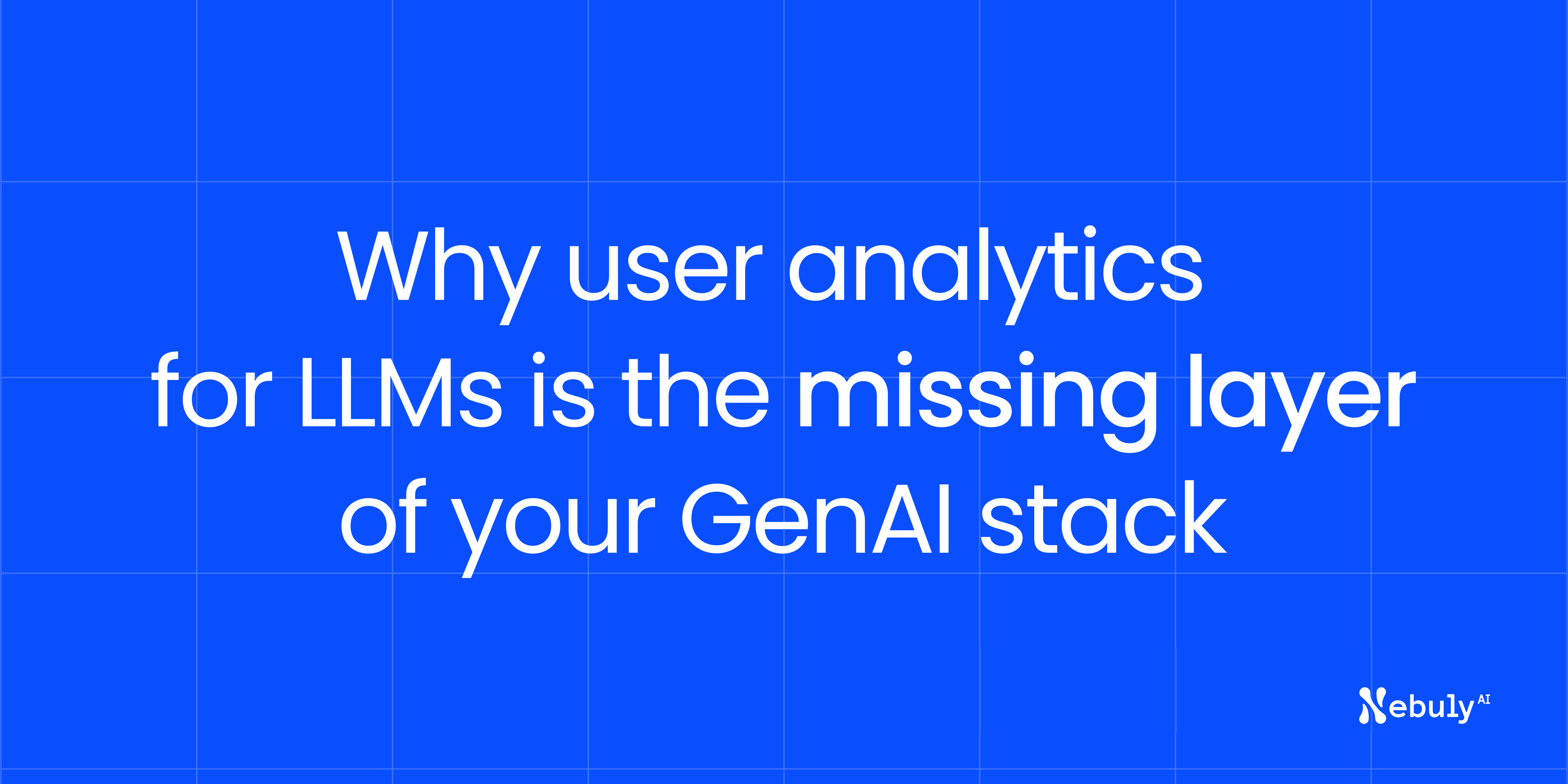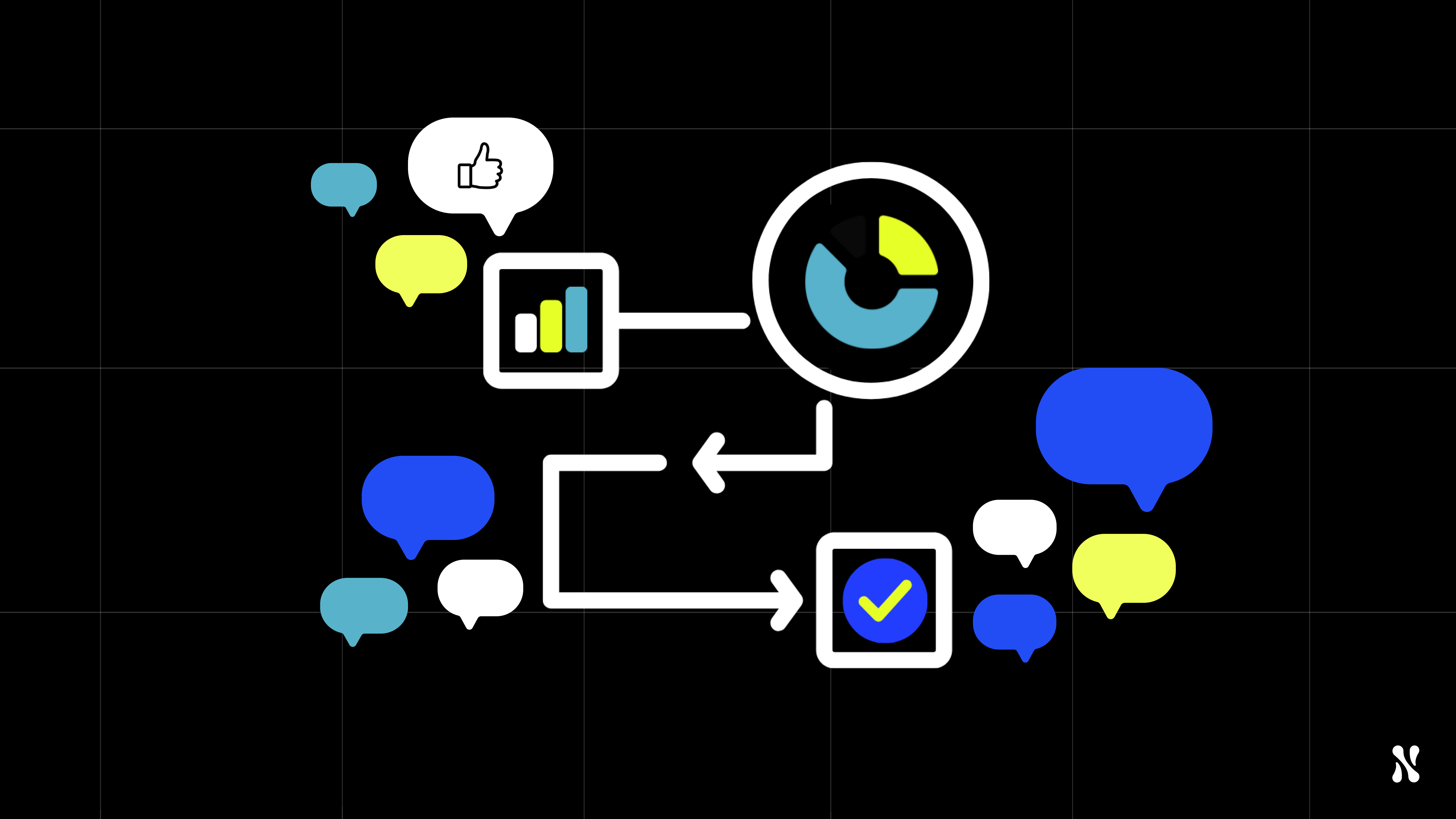Remember when web teams thought server‑uptime dashboards were “analytics”? Then Google Analytics arrived and showed that people, not packets, determined success. We’re at the same inflection point with generative AI today.
Most enterprises track technical metrics like latency, token usage and error rates, but those numbers don’t tell you whether people actually use (or love) your AI.
Without understanding the human side of AI interactions, teams optimize for the wrong things and adoption stalls.
The limitations of LLM observability tools
Traditional LLM observability tools measure technical performance but miss user experience. They tell you if your system is running, but not if it’s helping users accomplish their goals.
Implementing user analytics for LLMs provides insights that technical metrics alone can’t capture. Without this human layer, you’re flying blind on what actually matters for adoption and ROI.
Understanding AI user behavior: Beyond technical metrics
AI user behavior is fundamentally different from traditional app interactions. When users engage with AI systems, they:
- Start with unclear expectations – unlike clicking a button with a known outcome, users often explore what’s possible.
- Build context across multiple exchanges – the conversation history matters tremendously.
- Express frustration in detectable patterns – rephrasing, shorter messages, abandonment.
- Rarely provide explicit feedback – but their behavior speaks volumes.
Understanding AI user behavior requires looking beyond simple interaction counts. When a user abandons a conversation with your AI assistant, was it because they got what they needed quickly? Or because they got frustrated with unhelpful responses?
Patterns in AI user behavior often reveal opportunities for significant improvements. For example, one enterprise discovered that 70 % of their “error” tickets weren’t technical errors at all: users were simply giving unclear instructions. This insight led to implementing prompt suggestions that reduced support tickets by 32 %.
GenAI adoption metrics that actually matter
Traditional GenAI adoption metrics focus on system performance rather than user success. But the metrics that truly drive adoption include:
- Intent achievement rate – did users accomplish what they came for?
- Conversation completion rate – how many users abandon conversations before resolution?
- Rephrasing frequency – how often do users need to restate their questions?
- Return rate – do users come back after their first experience?
- Retention rate – how many users keep engaging over time, rather than dropping off after early use?
- Topic distribution – what are users actually trying to do with your AI?
The most valuable GenAI adoption metrics measure actual user outcomes and satisfaction. By optimizing for conversation completion rather than latency, organizations have increased successful transactions and improved user satisfaction.
Tracking the right GenAI adoption metrics can reveal why users abandon AI tools. This insight is critical for prioritizing improvements that drive adoption.
How AI conversation analytics transforms business outcomes
AI conversation analytics reveals patterns that help improve both models and interfaces. By analyzing the actual content of exchanges between users and AI systems, teams can:
- Identify common user intents – what are people actually trying to accomplish?
- Detect sentiment and emotion signals – where do users express frustration or confusion?
- Spot compliance and risk issues – where might sensitive information be exposed?
- Map the user journey – where do conversations typically derail?
Implementing AI conversation analytics helps teams identify where users struggle most. For instance, conversation analytics can reveal that different user roles (for example, clinical versus administrative) have completely different success metrics. This insight may lead to role‑based response templates that improve satisfaction scores.
The most valuable insights often come from AI conversation analytics rather than technical logs. While logs tell you what happened from the system’s perspective, conversation analytics reveals what happened from the user’s perspective.
Introducing Nebuly: Complete GenAI user analytics
Nebuly sits between your LLMs and users, capturing every interaction in real time. Think of it as Google Analytics for AI conversations, providing visibility into what users actually do, think, and feel when interacting with your AI systems.
Our engine automatically extracts:
- Intent & topic classification – what users are actually trying to accomplish.
- Sentiment, emotion & frustration signals – how they feel about the interaction.
- Risk & compliance flags – PII, toxic language, brand‑sensitive content.
- Drop‑off points – where conversations derail and users leave.
With Nebuly, teams can see exactly where users get stuck or frustrated with AI systems. This visibility enables rapid iteration and improvement based on actual user needs rather than assumptions.
Enterprises implementing Nebuly typically discover insights within the first week of deployment:
- “70 % of our ‘error’ tickets were really unclear instructions, now we surface prompt suggestions automatically.”
- “We discovered 3 % of prompts contained PII, fixed with Nebuly’s anonymization module before a compliance audit.”
How Nebuly complements your observability stack
You likely already use LLM observability tools like LangSmith, Helicone, Arize, LangFuse or Datadog to track system performance. These tools are essential: they tell you if your infrastructure is healthy, your costs are optimized, and your models are responding fast.
But here's the gap: observability platforms measure what the system did. They don't measure whether users actually benefit.
Nebuly sits alongside your observability stack, not replacing it. While LangSmith logs show you that a response took 200ms, Nebuly shows you that the user abandoned the conversation after that response. While Arize tracks token consumption, Nebuly reveals that users are rephrasing 40% of the time because responses aren't addressing their actual intent.
Organizations using both, observability tools for system health and Nebuly for user behavior, gain complete visibility. They can optimize infrastructure and user experience simultaneously, dramatically accelerating adoption and ROI.
Capturing LLM user feedback without disrupting experience
Collecting LLM user feedback doesn’t require disruptive surveys or ratings. Most users won’t click thumbs‑up or thumbs‑down buttons, but their behavior provides rich implicit feedback:
- Conversation continuation – users who keep engaging are finding value.
- Query refinement patterns – how users adjust when they don’t get what they need.
- Return frequency – users who come back find the system valuable.
- Session duration – longer isn’t always better; efficiency matters.
Analyzing patterns in LLM user feedback helps teams prioritize improvements. Some enterprises have found that new users frequently ask the same questions. Redesigning their onboarding flow with AI‑guided tutorials can increase new user activation.
Implicit LLM user feedback can be more valuable than explicit ratings. It shows what users actually do, not just what they say they think.
Overcoming AI adoption challenges with user insights
Many AI adoption challenges stem from poor user experience rather than technical issues. Common barriers include:
- Unclear capabilities – users don’t know what the AI can do.
- Trust issues – users don’t believe the AI will give correct information.
- Learning curve – users don’t know how to phrase effective prompts.
- Inconsistent experiences – the AI works sometimes but not others.
Organizations can overcome AI adoption challenges by focusing on user needs first. With proper analytics, teams can identify exactly where and why users struggle, then implement targeted improvements.
Understanding the root causes of AI adoption challenges requires user‑level analytics. For instance, conversations often stall on product‑specific terminology. Implementing a domain‑specific glossary can improve completion rates and reduce abandonment.
Key generative AI metrics for cross‑functional teams
Different teams need different insights from your AI systems:
An effective AI analytics dashboard shows both technical metrics and user experience data. Teams need a comprehensive AI analytics dashboard to make informed decisions about everything from model selection to interface design.
Nebuly provides an AI analytics dashboard that any team member can understand and use. No data science PhD required. Just actionable insights that drive better decisions.
Building an AI analytics dashboard that drives decisions
The most effective AI analytics dashboards combine technical and user‑centric metrics in ways that enable quick decision‑making. Key components include:
- User intent visualization – see what people are actually trying to do.
- Success/failure mapping – identify where users achieve goals versus get stuck.
- Sentiment trending – track how user satisfaction changes over time.
- Risk monitoring – spot potential compliance issues before they become problems.
- Topic distribution – understand which areas drive most usage.
Traditional generative AI metrics miss critical information about user satisfaction. By combining technical performance data with user experience insights, teams get a complete picture of AI system effectiveness.
Comprehensive generative AI metrics should include both technical and user experience data. This holistic view enables teams to make better decisions about everything from model selection to interface design.
How AI user sentiment analysis reveals hidden opportunities
AI user sentiment analysis goes beyond simple positive/negative classification. Modern techniques can identify:
- Frustration signals – repeated attempts, shorter messages, abandonment.
- Confusion indicators – questions about previous responses, clarification requests.
- Satisfaction markers – gratitude expressions, task completion signals.
- Trust signals – willingness to share information or take recommended actions.
These emotional signals often reveal the most valuable improvement opportunities. For example, companies may discover that users express the most frustration when asking about pricing — not because the information is wrong, but because it is too complex. Simplifying pricing explanations can improve conversion rates.
Why now: The competitive advantage of user‑centric AI
Conversational interfaces are marching toward ubiquity — just as websites did two decades ago. Early movers who measure what matters will iterate faster and pull ahead. Everyone else will wonder why their shiny copilot sits unused.
The organizations gaining competitive advantage today are those that:
- Measure both sides of the equation – technical performance and user experience.
- Iterate based on actual user behavior – not assumptions or technical metrics alone.
- Optimize for outcomes, not outputs – focus on user success, not just system performance.
As AI becomes embedded in every digital experience, the difference between leaders and laggards will be their ability to understand and optimize the human side of AI interactions.
Ready to see your AI through your users’ eyes?
Spin up Nebuly in minutes via API or deploy self-hosted in your own cloud (AWS, Azure, GCP, on-prem). Start turning every prompt into a product insight, and every conversation into business value.






